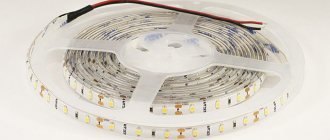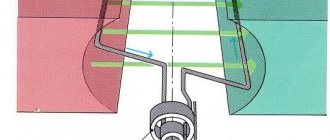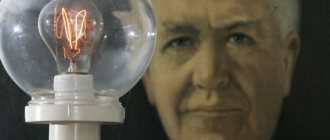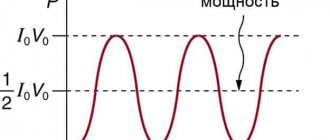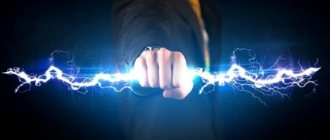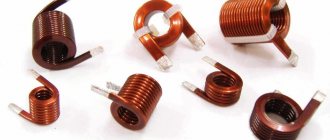The answer to the question of who invented electricity requires an analysis of the experiments and discoveries made in the industry. In search of an explanation for the phenomenon, which is a stream of charged particles, scientists have combined different areas of research. History gives the role of the founder of the science of electricity to Benjamin Franklin, who experimentally confirmed the electrical nature of atmospheric discharges. There are many other names of scientists, incl. beginners who made a great contribution to the development of the science of electricity.
History of origin
Many years ago, people observed natural phenomena of an electrical nature. In 600 BC. In Greece, it was experimentally established that fossilized resin rubbed with wool attracts objects.
In the 30s In the 20th century, archaeologists found pots containing copper sheets. These peculiar lighting batteries were discovered in Baghdad, which suggests that the development belongs to the ancient Persians.
In 1600, the word electricus was used by William Gilbert to describe the static energy produced by the mechanical interaction of substances. Thomas Brown used the category “electricity” (“amber”) in a number of research works. From this time on, an era of experiments began in order to unravel the nature of the phenomenon. The date of each of them is written into history.
In the 17th century a generator was invented, insulators and conductors were classified, particles with “+” / “-” charges were differentiated. Since the 18th century and humanity still produces, generates and consumes electricity.
The period of early discoveries prepared the basis for the development of science, research, and the development of equipment for transporting electricity.
Ancient time
The term “electricity” comes from the ancient Greek word “electron”, which means “amber”. The first mention of this phenomenon is associated with ancient times. Ancient Greek mathematician and philosopher Thales of Miletus in the 7th century BC. e. discovered that if amber was rubbed against wool, the stone acquired the ability to attract small objects.
In fact, it was an experiment in exploring the possibility of generating electricity. In the modern world, this method is known as the triboelectric effect, which makes it possible to produce sparks and attract objects of light weight. Despite the low efficiency of this method, we can talk about Thales as the discoverer of electricity.
In ancient times, several more timid steps were taken towards the discovery of electricity:
- ancient Greek philosopher Aristotle in the 4th century BC. e. studied varieties of eels that can attack an enemy with an electric discharge;
- The ancient Roman writer Pliny explored the electrical properties of resin in 70 AD.
All these experiments are unlikely to help us figure out who discovered electricity. These isolated experiments were not developed. The next events in the history of electricity took place many centuries later.
Stages of creating an electrical theory
The development of electromagnetism was facilitated by the experiments of Andre-Marie Ampere. The unit of current included in the SI was named in his honor. Charles Augustin de Coulomb studied friction processes and the properties of substances.
Otto von Guericke created the first electrical device. It was a sphere of sulfur mounted on a metal rod. Alessandro Volta developed a direct current generator. The research activities of Georg Simon Ohm influenced the development of the theoretical basis of this direction. German physicist Gustav Robert Kirchhoff discovered 2 laws of circuit theory. Heinrich Rudolf Hertz investigated the nature of waves in the medium.
Electric charge
All atoms are surrounded by a cloud of electrons carrying a negative () electric charge. Electrons move around the nucleus. The nucleus has the same total charge as all its electrons, but this charge is positive (+). Usually the positive and negative charges cancel each other and the atom is electrically neutral. But in some substances, some outer electrons have rather weak bonds with their atoms. And when two objects get lost with each other, such electrons can be released and migrate to the other object. As a result of this shift, the object becomes more electron-rich than it should be and gains a negative () charge. The second object has fewer electrons, so it receives a positive (+) charge. The charges thus generated are sometimes called "frictional electricity". Which object receives a positive or negative charge depends on the relative ease with which electrons move in the surface layers of the two objects.
If you wipe a polyethylene line with a woolen cloth, it will receive a negative charge, and if you wipe plexiglass, you will get a positive charge. In either case, the fabric receives a charge opposite to that of the waxed material.
Electric charges influence each other. Positive and negative charges are attracted to each other, and two negative or two positive charges repel. When one negative charge is applied to an object, the object's negative charges move to the other end of the line and the positive charges move closer to the line. The positive and negative charges of the line and the object attract each other and the object remains attached to the line. This process is called electrostatic induction, and the object is said to be caught in the electrostatic field of the fishing line.
Michael Faraday proved that frictional electricity and electric current are one and the same. He also proved that no electric field could exist in a metal cell (now called a Faraday cell).
From electrical theory to exact science
The practical base accumulated as a result of research made it possible to synthesize knowledge and learn how to manage energy. The basis for the formation of exact science was the discovery of the nature of current. The invention of artificial electricity dates back to the period of the 18th-19th centuries. Discoveries were made in a short period, which was associated with the active development of thought.
Thomas Edison made a great contribution to exact science. Nikola Tesla is credited with the theoretical confirmation of magnetism, and the scientist’s developments made it possible to obtain wireless electricity.
Law of Charge Interaction
This fundamental development belongs to Charles Augustin de Coulomb. The founder of the law of interaction of stationary charges established the dependence of the force of 2 point charges: the resulting forces obey Newton’s law.
Invention of the battery
Alessandro Volta's electrical device is a battery. The design is made in the form of a bookcase made of zinc and copper plates. Between them are pieces of felt soaked in sulfuric acid.
An electrical potential was created in the upper and lower parts of the energy source, the discharge of which was felt tactilely. Under the influence of the electrolyte, the interaction of metals occurred at the atomic level. Electrical energy was accumulated inside the structure. Volta's invention led to the development of batteries.
The emergence of the concept of current
This category emerged during the period of laboratory research into electricity by William Gilbert (1600). The concept characterized the ordered movement of particles of matter or such in a vacuum. The current could be of a constant nature or variable in nature. The force index determined the number of electrons, protons, and ions flowing through the cross section.
Electric Circuit Law
The activities of the German physicist Gustav Kirchhoff were associated with theoretical research. The researcher introduced the terms “branch”, “node”, “circuit”, and the established laws became the basis for the introduction of inventions in the electronic and technical industries.
The science that studies electricity
Electricity is a natural phenomenon. It is partly studied in biology, chemistry and physics. Electric charges are most fully considered within the framework of electrodynamics, one of the branches of physics.
Theories and laws of electricity
There are few laws that electricity obeys, but they fully describe the phenomenon:
- The law of conservation of energy is a fundamental law that also governs electrical phenomena;
- Ohm's law is the basic law of electric current;
- The law of electromagnetic induction – about electromagnetic and magnetic fields;
- Ampere's law - about the interaction of two conductors with currents;
- Joule-Lenz law - about the thermal effect of electricity;
- Coulomb's law - about electrostatics;
- Rules of the right and left hands - determining the directions of the magnetic field lines and the Ampere force acting on a conductor in a magnetic field;
- Lenz's rule - determining the direction of the induction current;
- Faraday's laws on electrolysis.
First experiments with electricity
The first experiments with electricity were mainly of an entertaining nature. Their essence was in light objects that were attracted and repelled under the influence of a poorly understood force. Another interesting experience is the transmission of electricity through a chain of people holding hands. The physiological effect of electricity was actively studied by Jean Nollet, who forced an electric charge to pass through 180 people.
Production and practical use
Since the advent of the first generators, many discoveries have occurred and inventions have been introduced into the field of energy generation and transmission.
As a result of scientific research since the last quarter of the 19th century. prerequisites have emerged for the development of the electric power industry, which include:
- creation of turbines;
- development of generators;
- transmission of electricity.
In 1801 in Germany, under the leadership of the Russian engineer M.O. A hydroelectric power station with an industrial capacity of 220 kW was built in Dolivo-Dobrovolsky. In the 20th century The era of widespread use of water energy potential began in the 21st century. The use of natural resources was gradually introduced and increased.
Minerals are used to produce electrical energy. Nuclear energy, which perfectly satisfies electricity needs, is considered the best option compared to alternative resources.
Electricity production (generation) is carried out at industrial facilities. Using hydrogen as a fuel, humanity achieves high combustion efficiency and takes care of environmental cleanliness.
Generation and transmission
The creation of mobile and high-power power plants has influenced the search for practical solutions for transmitting electricity over distances.
This was done through networks that included:
- lines;
- boost and buck converters;
- distribution devices.
The first experiments in transportation belonged to Stephen Gray, who in the 1720s. transmitted the charge through a silk wire.
In 1873, Fontaine demonstrated the use of a generator and a direct current motor connected by a wire 2000 m long. A breakthrough in the transmission of current over long distances was the experiment of M.O. in 1891. Dolivo-Dobrovolsky, during which a 3-phase line was used.
For the transmission range, the main parameter is throughput, the calculation of which takes into account the wave influence of the coupling resistance factors and the generated voltage.
Application
Electricity, being irreplaceable, is used for the following purposes:
- creating a lighting system;
- transfer of information;
- functioning of transport (trams, trolleybuses, trains);
- operation of household and office appliances;
- production and materials processing.
The scope of electricity is so wide that users often do not notice the existence of energy sources.
Where does electric current come from?
Electricity supplied through wires to homes is generated by an electrical generator at various power plants. On them, the generator is connected to a constantly rotating turbine.
The design of the generator has a rotor - a coil, which is located between the poles of the magnet. When the turbine rotates this rotor in a magnetic field, according to the laws of physics, an electric current appears or is induced. Thus, the purpose of the generator is to convert the kinetic force of rotation into electricity.
There are many ways to make a turbine spin, using a variety of energy sources. They are divided into three types:
- Renewable - energy obtained from inexhaustible resources: water flows, sunlight, wind, geothermal sources and biofuels;
- Non-renewable - energy obtained from resources that arise very slowly, incommensurate with the rate of consumption: coal, oil, peat, natural gas;
- Nuclear - energy obtained from the process of nuclear division of cells.
Most often, electricity arises through the work of:
- Hydroelectric power plants (HPPs) - are built on rivers and use the power of water flow;
- Thermal power plants (TPPs) – operate on thermal energy from fuel combustion;
- Nuclear power plants (NPPs) - operate on thermal energy obtained from the nuclear reaction process.
The converted energy travels through wires to transformer substations and distribution devices and only then reaches the end consumer.
Now so-called alternative types of energy are actively developing. These include wind generators, solar panels, the use of geothermal sources and any other ways to obtain electricity through unusual phenomena. Alternative energy is much inferior in productivity and payback to traditional sources, but in certain situations they help save money and reduce the load on the main power grids.
The advent of electricity in Russia
In the middle of the 17th century. Russian scientists Georg Richmann and Mikhail Lomonosov obtained an artificial discharge in a St. Petersburg laboratory. In 1874, Russian engineer A.N. Lodygin developed and received a patent for a lighting lamp, where the filament option was intended for a carbon rod.
After 16 years, this part of the structure was replaced with tungsten. P.N. Yablochkov presented a device using an electric arc. Its action was based on the occurrence of a spark between 2 kaolin electrodes.
He designed an electric arc lamp whose operating life was 4 hours. It was used to illuminate the Winter Palace. Yablochkov candles were used on locomotives as arc spotlights.
Public use
All these discoveries would not have become legendary without practical use. The first possible method of application was electric light, which became available after the invention of the incandescent lamp in the 70s of the 19th century. Its creator was Russian electrical engineer Alexander Nikolaevich Lodygin .
The first lamp was a closed glass vessel containing a carbon rod. In 1872, an application for the invention was filed, and in 1874 Lodygin was granted a patent for the invention of an incandescent lamp. If you try to answer the question in what year electricity appeared, then this year can be considered one of the correct answers, since the appearance of the light bulb became an obvious sign of accessibility.
Chronology of discoveries and inventions
In 1752, Benjamin Franklin confirmed the identity of the nature of lightning and sparks.
Alessandro Volta experimentally proved that a number of chemical reactions are accompanied by an electric flow. In 1800, he designed a battery to generate current and transmit it over a distance.
Later, Michael Faraday came up with a generator. This development helped Thomas Edison and Joseph Swan invent the lamp in 1878.
Current research was carried out by Emilius Lenz and Karl Gauss. In 1830, the electrostatic field was discovered. The platinum filament lamp was invented by Warren de la Rue. In the early 1900s. Nikola Tesla developed the commercial direction of this industry. Together with Thomas Edison, he developed a multiphase system for flow distribution. Thanks to his inventions, humanity uses household appliances.
Who invented electricity and when
A scientist from England, Stephen Gray, conducted experiments in 1729 that made it possible to detect the transfer of electrical charges over a distance of 250 meters. He also discovered that electricity does not travel through the ground.
Subsequently, this made it possible to divide all matter into insulators and conductors. Charles Dufy discovered in 1733 that there are two types of charges in nature, or, as he called them, “the electricity of resin and the electricity of glass.” He then explored electrical interactions, proving that objects with different poles attract and objects with the same pole repel each other. During these experiments, the French inventor came up with an electrometer that allowed him to measure the magnitude of charges. In 1745 in Leiden, the Netherlands, scientists Charles Dufay and Ewald von Kleist discovered the possibility of accumulating charge in a capacitor. Ewald charged the steel nail from the electric machine and began to remove it from the jar he was holding with his other hand. When he touched the nail, he received a noticeable energy shock. As a result, the possibility of energy storage was discovered. A little later, Professor Peter von Muschenbruck repeated his experiment. He poured water into a glass container and dipped copper wires into it. When the scientist tried to touch the charged copper wire, he received a strong electric shock.
This is how physics began to develop as a science.
Interesting Facts
Ancient Egyptian doctors, searching for new remedies, knew about the ability of the Nile catfish to accumulate electricity.
Inventions in this industry were preceded by observations of nature:
- Plato and Aristotle mentioned stingrays and their influence on people.
- Pliny the Elder drew attention to the properties of water and metal as conductors.
- In 1819, Hans Christian Oersted studied the effect of electric current on a compass.
- At the time of Nikola Tesla, direct current was difficult to transform into high and low voltage, so the scientist advocated alternating current. Thomas Edison, who patented the developments and did not want to lose royalties from them, launched a campaign to discredit them. When N. Tesla illuminated the city with electricity obtained from a station at Niagara Falls, using alternating current for transmission over a distance, General Electric financially supported the scientist.
- As a result of a powerful lightning strike, a mineral such as fulgurite is formed. Hollow branched tubes with a smooth or bubble-covered surface are formed in the soil.
- At the Earth's surface there is a constant electric field with an average strength of 130 V/m.
- Linear lightning that strikes the ground and forms clouds is a type of spark discharge. It occurs in a mass of charged and isolated particles. Discharges are accompanied by electromagnetic radiation in a wide frequency spectrum.
Interesting facts in the history of electricity are associated with natural phenomena, the developments of scientists, and the achievements of science and technology.
Modern round of research
A grandiose breakthrough in the development of electrical engineering was made by the legendary scientist, physicist and inventor Nikola Tesla at the turn of the 19th and 20th centuries. Many of Tesla's inventions are still awaiting a new round of research in the field of electrical engineering in order for them to be put into practice.
Currently, research is underway to obtain new superconducting materials and create advanced components for electrical circuits with high efficiency.
Additional Information. The discovery of graphene and the production of new conductive materials from it predict enormous changes in the use of electricity.
Science does not stand still. Every year, humanity witnesses the emergence of more advanced sources of electricity, along with the creation of devices, machines and various units that consume environmentally friendly energy in the form of electric current.
Batteries
There are a large number of different electric batteries, but there are always two factors in your device. They are necessarily composed of two different chemical elements (for example, zinc, copper, carbon and copper, zinc and mercury) and a liquid separating them (in the case of the Volta element, this is a saline solution). The liquid is called an electrolyte. Sometimes the electrolyte is in the form of a paste to prevent leakage.
The presence of different chemical elements is necessary for the same reason as the use of different materials to produce static electricity through friction. In one material, electrons move more freely and therefore tend to move in another material. In an electrical cell, two plates and the liquid between them are electrical conductors. The electrons "released" during a chemical reaction can move without interruption, there will only be space. Thus, the electrical circuit becomes space. The flow of electrons can be stopped when the circuit is broken. In an apartment, this role is played by a switch.
In batteries, calculators, portable receivers and hearing aids, the wet paste acts as an electrolyte. The batteries produce electricity as long as the chemical reaction continues.
In cheap batteries, one chemical element is the zinc reservoir and the other is the carbon electrode. Over time, the zinc tank melts, so the outer shell of these batteries is sealed to prevent contents from leaking and other things being damaged. Long life alkaline batteries contain the same chemical elements but a different electrolyte. In small round batteries used in watches, the chemical plates consist of zinc and mercury or zinc oxide and silver.
Some batteries can be charged with current in the reverse direction. These batteries are usually charged with nickel and cadmium. Cells should only be charged when the charger voltage is correct. You should never try to recharge a regular battery. Car and electric vehicle batteries contain liquid, so they should only be kept in an upright position. They usually run on lead and lead dust and can be recharged many times. Electrolytes are often diluted with sulfuric acid, so they are usually sealed.
Electric cars are silent and do not pollute the air (although the air is polluted by the power plants that supply the chargers). Attempts are currently being made to produce rechargeable car batteries that are lighter than existing batteries. It is likely that one day there will be rechargeable batteries with plastic cells.
Voltage and current
The following description will help you better understand what current and voltage are.
So there are two tanks connected by a pipe and water is poured into one tank. Water is added until the water level in both tanks is the same. When you raise one tank above another, water flows from one tank to the other until the levels are equal again.
The greater the difference between the water levels in the two tanks, the faster the water flows. The speed of water overflow is equal to the speed of current. At this speed, free electrons move in a metal wire. The difference in water level is comparable to electrical voltage. The higher the voltage, the stronger the current flows.
Batteries in flashlights and walkie-talkies have voltages ranging from 1.5 to 9 volts. The exact value depends on the composition and number of elements in the battery. Household electrical voltage ranges from 100 to 240 volts depending on location.
Thunder and lightning
Thunderstorms usually occur during hot weather in summer; when the hot air flowing from the surface of the earth is saturated with moisture, they rise. When water droplets and ice crystals spin in the air currents of thunderclouds, they become charged with electricity. Tiny, positively charged ice crystals move upward, while negatively charged gradients collect at the bottom of the cloud.
Just as small objects are attracted by electrostatic induction from a charged fishing line, a charged cloud is attracted to the ground. The negative charge on the underside of the cloud is attracted by the positive charge to the ground, and a strong spark (lightning) is formed between them. A lightning discharge heats the air and causes it to expand, accompanied by a thunderous sound. Sound travels through air much more slowly than light, which is why we see lightning first and then hear thunder.
When friction occurs, metals not only become easily electrified, but also conduct electricity very well. Therefore, when a metal object is in the hands of a person, a charge passes through the human body. Electricity generated by friction is more common in materials that are poor conductors, such as glass, rubber, plastic, resin, these materials are called insulators. Since no electricity is transmitted through them, they are called static electricity. Faraday also called it "ordinary" electricity, but nowadays we use electric (moving) current everywhere. So now it's more of a "regular" thing.
If you have rubber or plastic soles and have walked on carpet, you will feel a slight electric shock when you touch a metal doorknob. This means that your body has had time to charge itself with electricity when you rub the soles of your feet on the carpet,
Sometimes a person gets electrocuted when he gets out of his car and closes the door. He is most likely wearing wool or cotton clothing that has been electrocuted by a synthetic car seat. If it also has a rubber or synthetic sole that has an insulating effect, then the charge can only be released if it touches the metal handle. To avoid this, you can try touching something metal inside the car before leaving. Then the charge will be reduced and there will be no unpleasant effects,
Electricity 2600 years ago
One of the tools discovered at an archaeological site near Baghdad resembles an electrochemical cell
Around 600 BC, the Greek mathematician Thales of Miletus discovered that the friction of fur against amber caused an attraction between the two. Later observations proved that this attraction was caused by an imbalance of electrical charges called static electricity.
Archaeologists have also found evidence that ancient people may have experimented with electricity. In 1936, they found a clay pot with an iron rod and a copper plate. It is similar to an electrochemical (galvanic) cell.
It's unclear what this tool was used for, but it sheds some light on the fact that ancient people may have been studying early forms of batteries long before we know it.
Real electric charge
Although the electrical shocks described above are unpleasant, they are nevertheless safe for humans. However, in some cases, the electrical charge caused by friction can lead to accidents. There have been cases of giant supertankers exploding when their fuel tanks were washed away by powerful water cannons. Electric charges arise from the friction of water droplets in the jet of a water gun. This effect is similar to the effect of an air current consisting of water droplets rising in a thundercloud. In such conditions, despite the humid environment, sparks may be generated that threaten to ignite gasoline vapors remaining in the tank.
The plane can also become electrically charged when it encounters a thundercloud or when the landing gear rubs against the ground during landing. In the past, electrical sparks that accumulated on the surface of an aircraft posed an explosion hazard. But now the necessary precautions are being taken. For example, the chassis tires are made of electrically conductive material. Corona (discharge) electrodes are attached to the ends of the aircraft's wings, and all the electricity is collected at the ends of the wings and "sprayed".
Safety measures are also necessary when refueling, since the friction that occurs in the flow of gasoline can undoubtedly lead to a large charge. That's why gasoline pumps are made of iron.
Electricity generated by friction or static electricity is used by humans in various ways. Particles of soot, ash and similar particulates are released into the air along with smoke from numerous plants and then return as deposits. Thanks to electrostatic precipitators installed in the pipes, approximately 98% of particulate matter can be collected and removed before it enters the air. This process is called electrostatic dust removal. In the US, it prevents 20 million tons of soot from being released into the air each year. A special spray system is used for painting cars and aircraft. However, up to 25% of the paint evaporates each time. This can be avoided by imparting an electrical potential to the sprayed particles. Electrolytic paint particles begin to be attracted to the surface of the car or aircraft and adhere better. The savings from efficient use of the spray system exceed the cost of loading the equipment.
The same technology is used for powder coating. The electrified coating appears to adhere to the metal, and when the surface is heated, the powder coating forms a thin, permanent layer.
Electric charge and powder are also used in photocopiers. The text or design appears on the lens and must be copied. This black and white drawing is transferred to paper as a drawing of charged and neutral areas. When black powder is applied to paper, it is attracted only to the charged areas. The powder is then attached to the paper by hot air. This copying technique is called xerography. It is also used in fax machines.
The effect of electricity on living organisms
Electricity plays an important role in life processes. Laboratory studies have confirmed its positive effect on plants, seed germination, photosynthesis. A charged stream of particles can protect gardens from biological pests, and irradiation of fruits prevents the process of rotting.
The effect of electric current on a person
In the statistics of industrial injuries, electrical injuries have a low rate. Its danger lies in the fact that the person affected by the current cannot independently help himself. Electric current has thermal, biological, and electrolytic effects. The resistance of the human body depends on the circuit parameters, physiological state, and environmental conditions.



